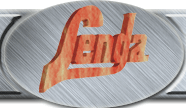| |
 |
|
||||||||
| |
|
|
|
|
|
|
|
|
|
|
| |
|
|
|
|||||||
If there is a letterstyle you wish to use or have reproduced, we have several options to follow. The first would be to send us the font installed you used on your system . The second option is to send the lettering converted to outlines. The third would be to send us a large bitmap file. Last would be a large clean print to scan.
If you sent us a copy of the True Type Font (.ttf)
installed
on your computer we would be able to use it in much the same way you
can
on your computer. This file is designated with a .ttf extension
and
is found in the system directory of Windows or the Fonts directory of
Windows
95, NT and MAC. (Postscript fonts will also work on MAC platform
only)
Once we have this file, we can produce lettering in any size, color, or
special effect available for our installed letterstyles.
Most good draw programs have a "convert to outline" option. This
is apparent when you are able to edit the shape of the letters by their
anchor points. Once the lettering is in outline form the originating
system
font is no longer used and the image file can be sent. This must
be saved in a file format that can support a Vector image, preferably
Adobe
Illustrator (.ai). However .eps, and .dxf will also work. If this
option is used then only the image sent can be used. We cannot use it
as
a lettersyle. Please keep in mind these images will be cut not printed.
Strokes and patterns will not apply to the cutting method, but
may
reproduced another way.
Another option is to sent us a digital bitmap or raster image large enough for us to cleanly convert into a form we can use. To do this we need to have the shape (letter) size be at least 1" tall at 300 dpi. This should be just the letter size and not include the surrounding area. File size can be reduced by making sure the image is B & W bitmap and saved with .jpg compression, or .tif (lzw compression). If colors are a must then keep them to a minimum, and use index colorspace to assist compression. We cannot use this as a letterstyle, only reproduce what is on the image.
The final option would be to scan from artwork. This artwork should have the lettering be as large as possible and still fit on an 8 1/2 x 14 paper. If the smallest lettering is at least 1 inch and have good edges ( no staircasing ) there should be no problem reproducing. B & W or images with minimal spot color work best. Again, we can reproduce only what is on the image.